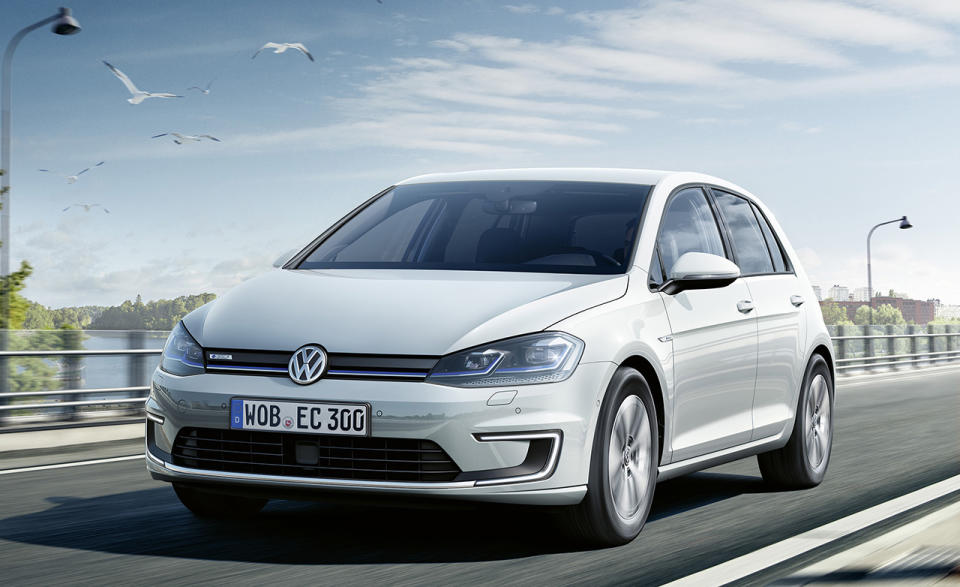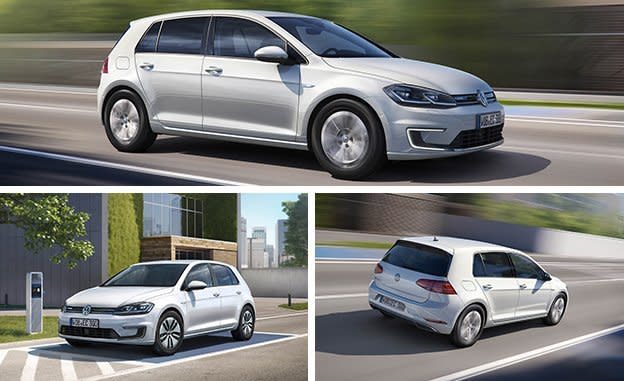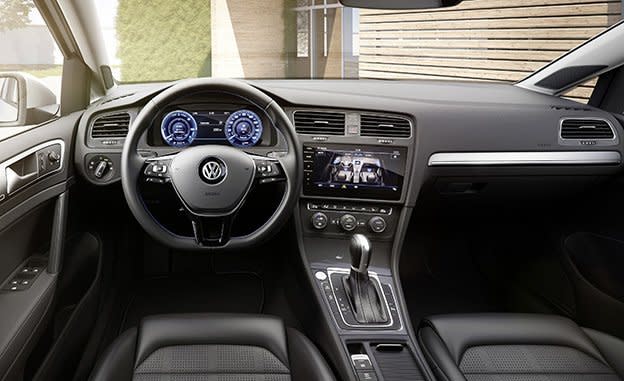Fore! 2017 Volkswagen e-Golf Travels 50 Percent Farther on a Charge

Chevrolet’s $37,495 Bolt EV, with its 238-mile driving range and newness relative to its competitors, is casting a green shadow over other affordable electric cars. Not only is it newer, but its range far exceeds that of the only somewhat less expensive Nissan Leaf (107 miles per charge), the Ford Focus Electric (100 miles), and Volkswagen’s e-Golf, which until now has only been able to muster an EPA-certified 83 miles of range. But wait! For the 2017 model year, that figure blows up by 50 percent . . . to 124 miles.
That’s not news that threatens the Bolt’s leadership, but it does show that Volkswagen, like Nissan and Ford, is trying to catch up. (The EPA-certified driving range figures for the 2017 Leaf and the 2017 Focus EV also are notably higher than those for last year’s iterations.) The Golf’s improved driving range comes by way of a new 35.8-kWh lithium-ion battery pack, versus the 2016 e-Golf’s 24.2-kWh battery of the same chemical variety. (By comparison, the Bolt’s battery sports an energy capacity of 60.0 kWh.) Volkswagen also has made the previously optional 7.2-kW onboard charger standard, meaning that when pulling electrons from a 240-volt power source recharge time has dropped to less than six hours. A DC fast charger that can replenish the battery to 80 percent of its capacity in about an hour is optional on the base SE and standard on the SEL Premium.

Volkswagen also upgraded the electric motor, netting an additional 19 horsepower and 15 lb-ft of torque for new totals of 134 horsepower and 214 lb-ft. The newfound oomph cuts more than a second from the e-Golf’s zero-to-60-mph time according to VW, dropping it to 9.6 seconds. Given that a 2016 e-Golf we recently tested hit 60 mph in 9.4 seconds, Volkswagen’s figures are likely conservative, and yet this is still no “whee-Golf.” The car’s top speed increases to 93 mph, although as is the case with any EV, driving at top speed quickly drains the battery pack.
The 2018 Golf, Today!
If the e-Golf’s exterior looks different, yet familiar, that’s because it wears the new headlights, taillights, front fenders, and bumpers from the refreshed, European-market Golf. Our regular, gas-powered Golf won’t see those changes until the 2018 model year, a wait that gives the e-Golf’s styling some novelty, at least for the next few months. As before, the front end features large C-shaped LED running lights and a thin blue accent stripe across the plastic plate that substitutes for the gas-powered car’s grille.

Inside, the e-Golf takes a fistful of goodies from Volkswagen’s future interior-technology basket, namely a huge 9.2-inch touchscreen that’s integrated into the dashboard. The unit will at an unspecified time (this year or next) add the gesture-control capability that VW demonstrated at this year’s Consumer Electronics Show. It allows users to swipe through a horizontal main-menu structure, change radio stations, or skip songs using only a wave of the hand. We tried it for ourselves and found it worked, even if it suffers the same “but why?” air of pointlessness as other automakers’ gesture-control efforts. That party trick aside, the e-Golf also can now be optioned with a 12.3-inch digital gauge cluster that displays driving data, audio information, and navigation directions. The available forward-collision warning and automated emergency braking functions now respond to wayward pedestrians, as well as to other vehicles and obstacles, although the advanced safety gear is only available on the top-flight e-Golf SEL Premium as part of a new package with the digital dashboard, adaptive cruise control, blind-spot monitoring, automatic high-beams, and parking assist.
Last year, the e-Golf SE started at $29,815 (before the $7500 federal tax credit and any state or local incentives). If the 2017 model holds the line on that pricing when it goes on sale early next year, it keeps the inevitable comparisons to the Chevy Bolt at a $7680 distance. The e-Golf is an agreeable electric car. It may not be a purpose-built EV, like its Chevrolet foil, but it sees far less compromise than other electrics that were developed primarily as gas-powered compacts. The battery doesn’t intrude on cabin space, and the current e-Golf is quite pleasant to drive and to look at—just like the regular Golf, which we’ve named one of our 10Best Cars of 2017. Volkswagen would probably prefer we didn’t point out that the Bolt nabbed the same award, but such is the lot of any affordable EV without a bow-tie badge in 2017.


 Yahoo Autos
Yahoo Autos 